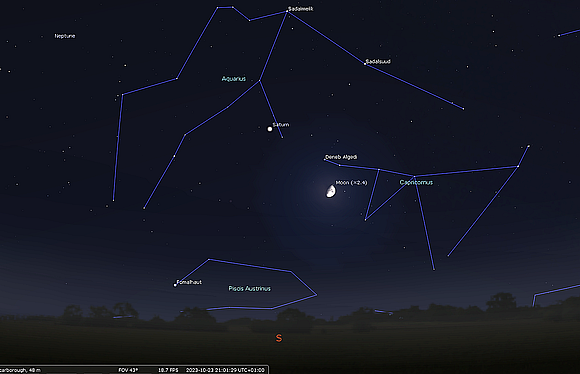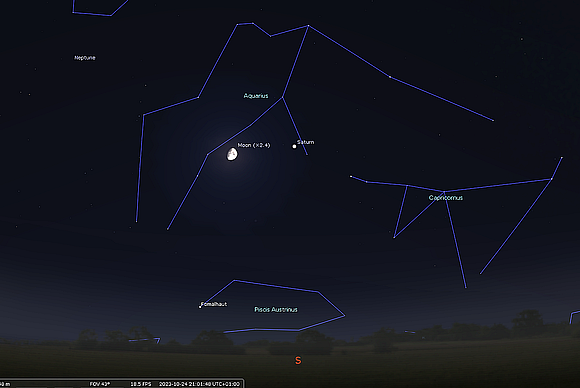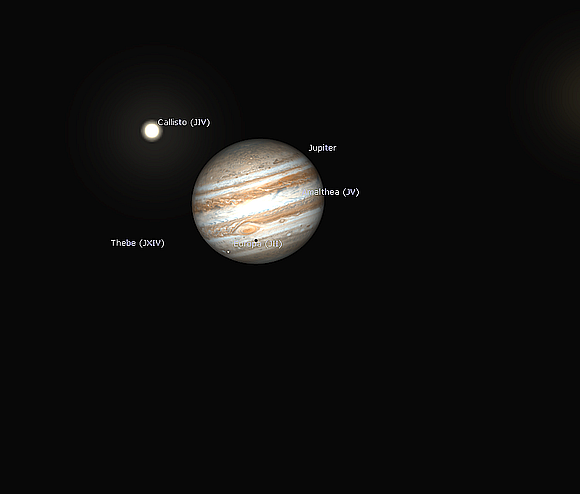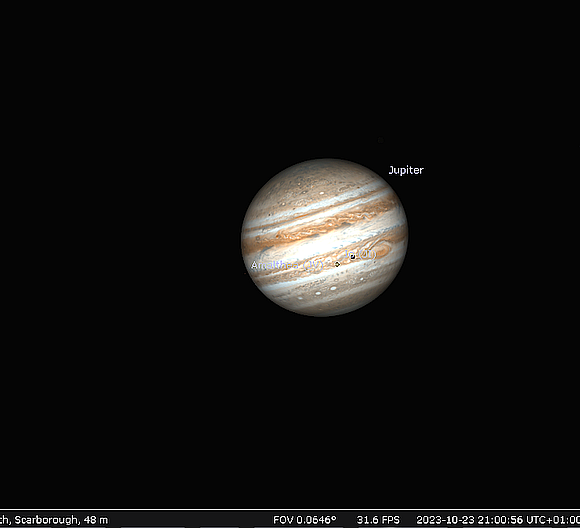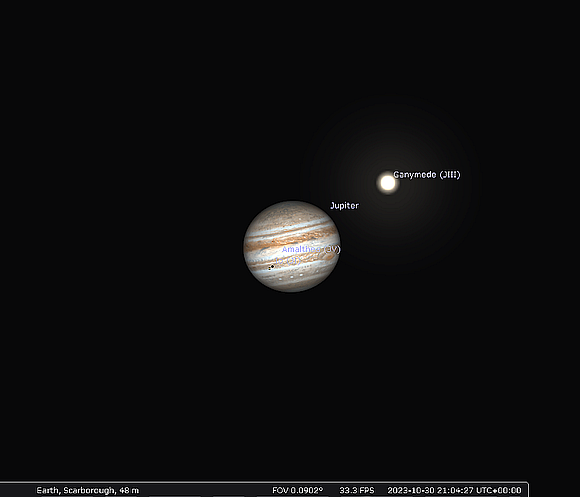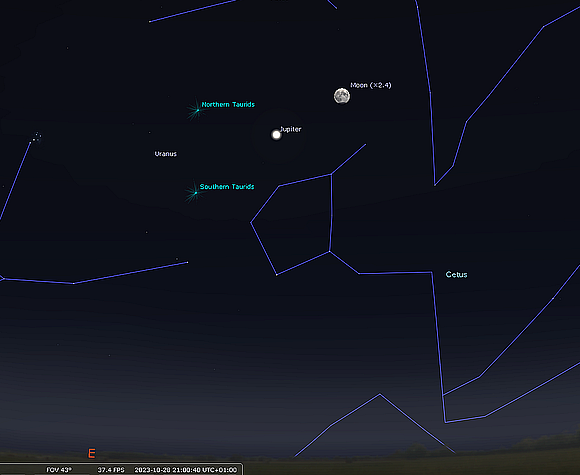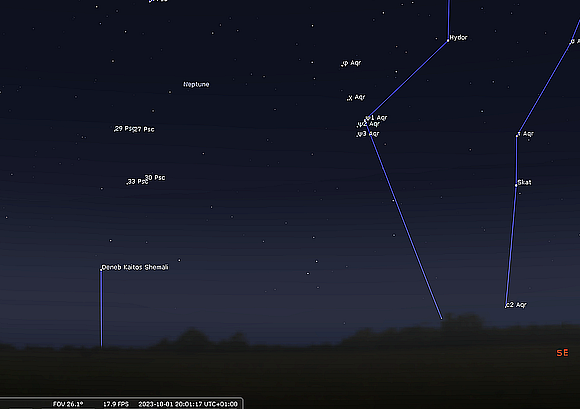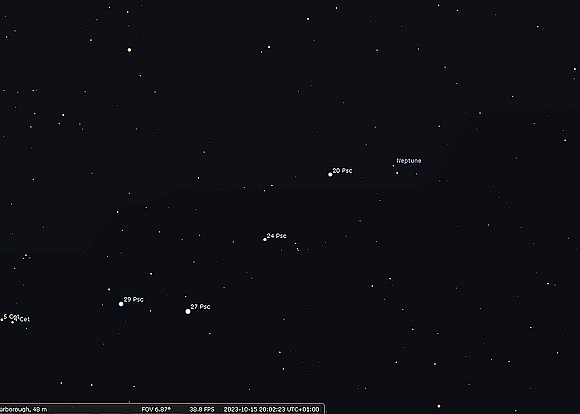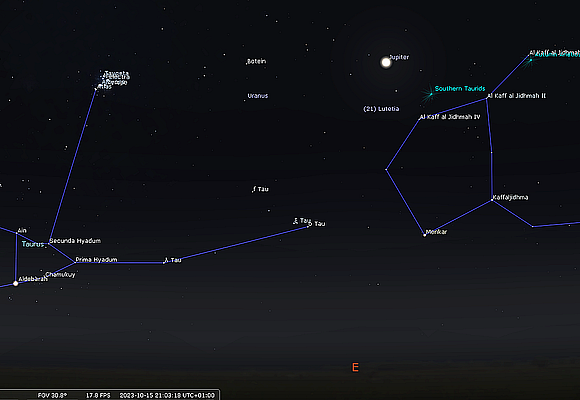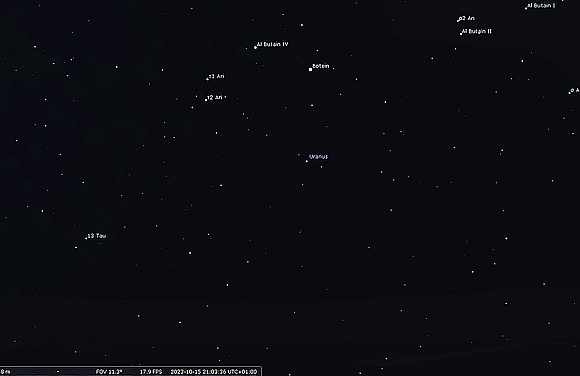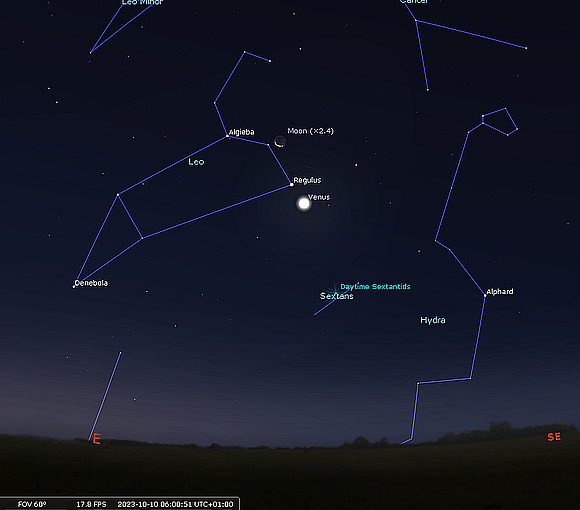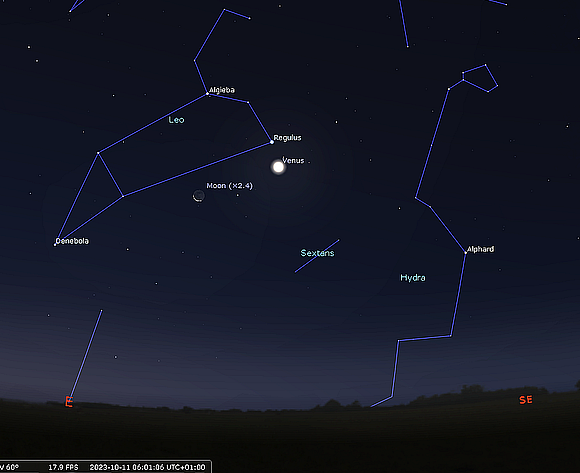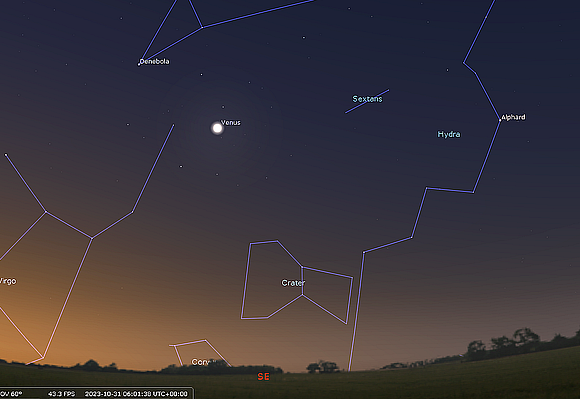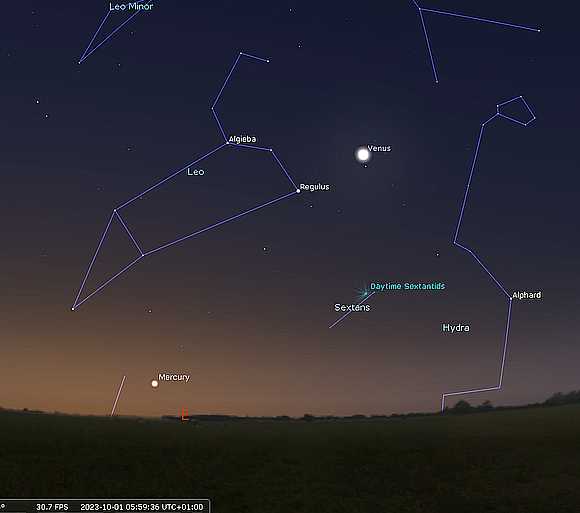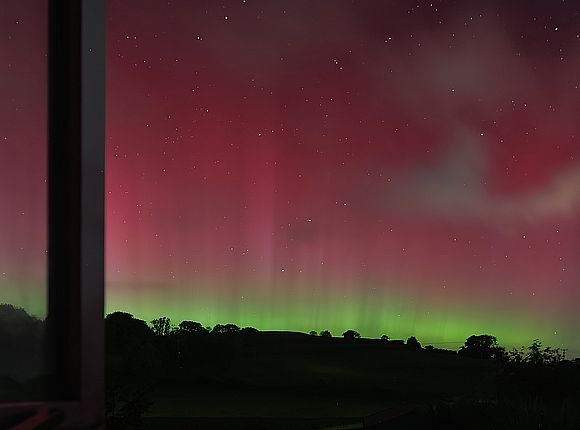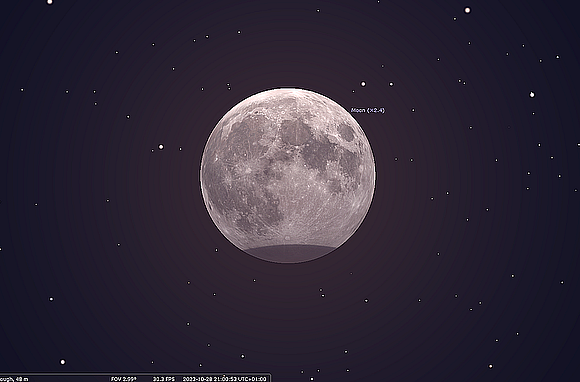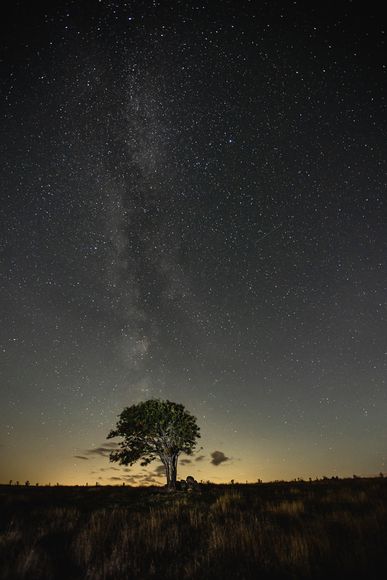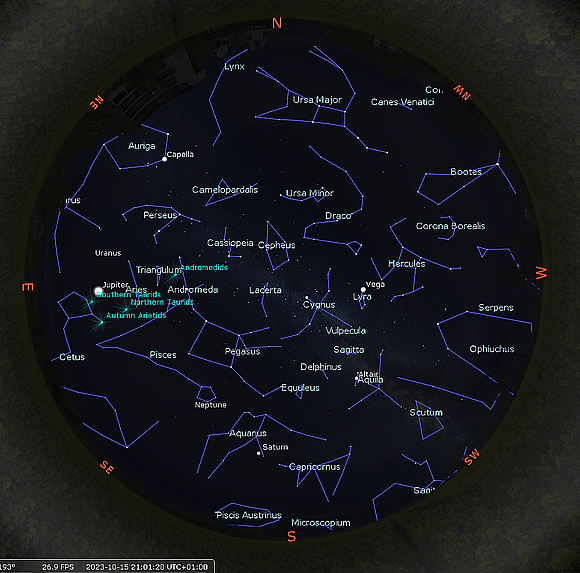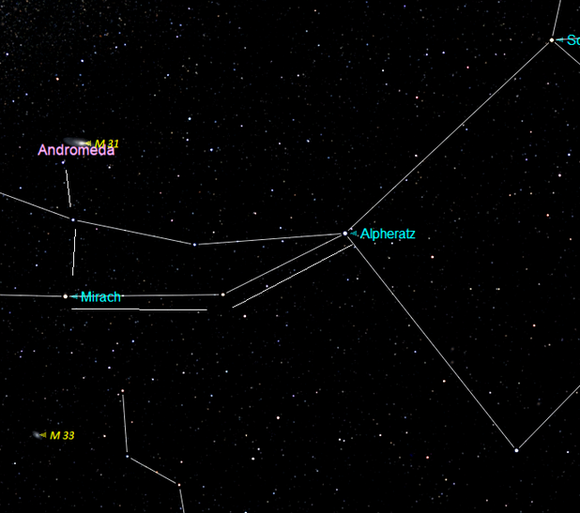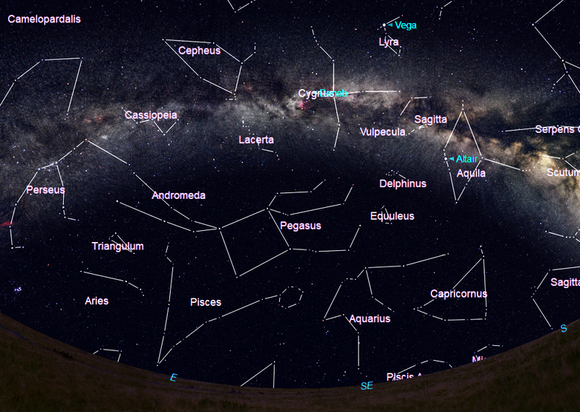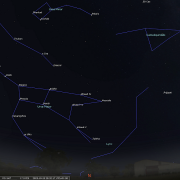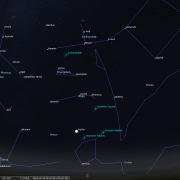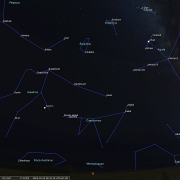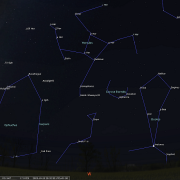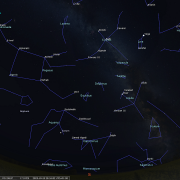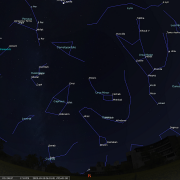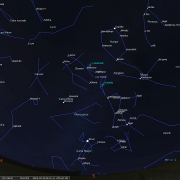cIn this month's Sky Notes:
- Planetary Skylights
- October Meteors and Aurora sighting
- Partial Lunar Eclipse
- October Night Sky
- October 2023 Sky Charts
Planetary Skylights: A Brief Guide to October's Night Sky
Saturn is ideally placed in the evening sky. Jupiter is very conspicuous as it nears opposition early next month. Uranus and Neptune are both visible as telescopic objects in the evening sky. Mercury rounds off a fine morning apparition in the eastern dawn sky, an aspect dominated by brilliant Venus.
 Saturn is already above the horizon as darkness falls and by mid-month lies due south around 21:00hrs BST, ideally placed for observation. At magnitude +0.4, Saturn resides amongst the faint stars of southern Aquarius a region of the sky devoid of brighter stars thus making Saturn stand out. Saturn is still 11 degrees below the celestial equator, roughly 20 - 23 degrees above the horizon from the UK, but will continue to gain in declination over the coming decade crossing into the northern half of the sky by 2026.
Saturn is already above the horizon as darkness falls and by mid-month lies due south around 21:00hrs BST, ideally placed for observation. At magnitude +0.4, Saturn resides amongst the faint stars of southern Aquarius a region of the sky devoid of brighter stars thus making Saturn stand out. Saturn is still 11 degrees below the celestial equator, roughly 20 - 23 degrees above the horizon from the UK, but will continue to gain in declination over the coming decade crossing into the northern half of the sky by 2026.
Through the eyepiece Saturn can be a splendid sight, although the orientation of the ring system is becoming less favourable, tilted by just 9 degrees or so. This will increase to 10 degrees by December before closing with the next ring plane crossing occurring in 2025. Distinction of the outermost ring (ring A) and the broader ring B on the inside is becoming far more challenging for smaller instruments under 150mm (6") and we have found it difficult to detect the Cassini division, the major gap between ring A and B, in 250mm (10") scopes. You will spot Saturn's largest moon, Titan, in nearly all apertures, visible as a speck of light nearby. On October 23rd a waxing Quarter Moon resides below-right of Saturn and off to the left the following evening.
 As we head through October Jupiter’s presence in the evening sky becomes ever more conspicuous, rising approximately 80 minutes after sunset at the start of October, and already above the east horizon as twilight deepens (17:15hrs UT) by the month's end. Residing in the lower reaches of Aries, at magnitude -2.8 Jupiter dominates that whole aspect climbing to over 30 degrees in elevation by 23:00hrs (higher than Saturn) and 50 degrees in the post-midnight hours. This is good news for UK observers being well above poor ‘seeing’ layers closer to the horizon. Jupiter is now in retrograde motion, moving east to west as it heads toward opposition in early November.
As we head through October Jupiter’s presence in the evening sky becomes ever more conspicuous, rising approximately 80 minutes after sunset at the start of October, and already above the east horizon as twilight deepens (17:15hrs UT) by the month's end. Residing in the lower reaches of Aries, at magnitude -2.8 Jupiter dominates that whole aspect climbing to over 30 degrees in elevation by 23:00hrs (higher than Saturn) and 50 degrees in the post-midnight hours. This is good news for UK observers being well above poor ‘seeing’ layers closer to the horizon. Jupiter is now in retrograde motion, moving east to west as it heads toward opposition in early November.
Through the eyepiece Jupiter’s oblate globe is a whopping 47 arc seconds in diameter, making for pleasing observations - even with modest instruments. The darker cloud belts should be obvious, but when turned in our direction look for the great red spot feature, (currently neither) appearing paler and smaller than 25 years ago. The GRS can be observed in 75-100mm (3”- 4”) scopes but will be more obvious in 150mm (6”) instruments at medium powers. Look for the GRS on the 6th, 13th, 18th, 23rd & 25th at 21:00hrs BST.
One Jovian system feature all observers using optical aid will notice are the attendant Galilean moons, the dance of these four large bodies over successive nights is fascinating to follow. Seen as specks of light the configuration and number of the Galilean moons constantly evolve as they orbit around Jupiter. Look for Galilean moon shadow transits on the disk of Jupiter in particular, of which there are many, but the more favourable for late evening observers are Ganymede - Oct 5th/6th from 23:30hrs BST, Europa - Oct 20th from 21:00hrs and Io – 23rd from 21:00hrs BST and the 30th from 21:00hrs GMT. The GRS will be visible at the same time for all.
Overnight of Oct 1st look for a waning gibbous Moon nearby Jupiter, whilst on Oct 28th the Full Moon (in partial lunar eclipse) is in conjunction with Jupiter making for a fine spectacle. The following evening the Moon lies off to the left.
 Neptune is well placed for telescopic observation having reached opposition last month. The official outermost planet resides approximately 15 degrees east of Saturn, below the faint loop of stars marking the western fish of Pisces in particular lambda Piscium (mag 4.5). The nearest 'bright' star is 5th magnitude 20 Piscium -30 arcminutes to the right of Neptune. Neptune itself is 7th magnitude appearing as a tiny 2.4 arc-second disc through the eyepiece. You will require at least a 100mm (4") aperture at 100x magnification to glimpse this, but Neptune is visible as a speck in humble 10x50 binoculars (if you know exactly where to look). Bear in mind Neptune is very remote, over 4.3 billion Km (2.67 billion miles) or 28.9 AU distant.
Neptune is well placed for telescopic observation having reached opposition last month. The official outermost planet resides approximately 15 degrees east of Saturn, below the faint loop of stars marking the western fish of Pisces in particular lambda Piscium (mag 4.5). The nearest 'bright' star is 5th magnitude 20 Piscium -30 arcminutes to the right of Neptune. Neptune itself is 7th magnitude appearing as a tiny 2.4 arc-second disc through the eyepiece. You will require at least a 100mm (4") aperture at 100x magnification to glimpse this, but Neptune is visible as a speck in humble 10x50 binoculars (if you know exactly where to look). Bear in mind Neptune is very remote, over 4.3 billion Km (2.67 billion miles) or 28.9 AU distant.
 Uranus lies less than 6 degrees left of Jupiter and a similar distance to the right of the Pleiades star cluster. Uranus is mag +5.8 and is of a soft green/grey hue. Technically visible to the naked eye, an aperture of 75-80mm (3") is needed to spot the tiny 3.5-degree disk. A 'used' Full Moon lies above Uranus on October 29th. Uranus comes to opposition next month.
Uranus lies less than 6 degrees left of Jupiter and a similar distance to the right of the Pleiades star cluster. Uranus is mag +5.8 and is of a soft green/grey hue. Technically visible to the naked eye, an aperture of 75-80mm (3") is needed to spot the tiny 3.5-degree disk. A 'used' Full Moon lies above Uranus on October 29th. Uranus comes to opposition next month.
 Venus makes a superb sight in the dawn sky for any early risers. The brilliant 'morning star' is certainly conspicuous, a real beacon, blazing forth at magnitude -4.5. At the start of October Venus is rising shortly after 03:00hrs, attaining an altitude of 30+ degrees by 06:00hrs, well clear of murk and turbulent air. By the month's end (after clocks have gone back one hour) Venus will be visible above the east horizon by 02:45hrs UT. Venus pulls out to greatest western elongation from the Sun on October 23rd some 46 degrees making it for UK observers about the best apparition Venus can attain! Turn a telescope towards Venus and the sight will be dazzling, so, if possible, wait until skies begin to lighten a little to better discern the phase. This will grow from a 36% to a 54% illuminated disk by the month's end. View on the 10th when a waning crescent Moon sits above Venus with the 1st magnitude star - Regulus in Leo in between.
Venus makes a superb sight in the dawn sky for any early risers. The brilliant 'morning star' is certainly conspicuous, a real beacon, blazing forth at magnitude -4.5. At the start of October Venus is rising shortly after 03:00hrs, attaining an altitude of 30+ degrees by 06:00hrs, well clear of murk and turbulent air. By the month's end (after clocks have gone back one hour) Venus will be visible above the east horizon by 02:45hrs UT. Venus pulls out to greatest western elongation from the Sun on October 23rd some 46 degrees making it for UK observers about the best apparition Venus can attain! Turn a telescope towards Venus and the sight will be dazzling, so, if possible, wait until skies begin to lighten a little to better discern the phase. This will grow from a 36% to a 54% illuminated disk by the month's end. View on the 10th when a waning crescent Moon sits above Venus with the 1st magnitude star - Regulus in Leo in between.
 Mercury is heading toward the end of a fine dawn apparition, having reached greatest elongation on Sept 22nd - some 18 degrees. As with all morning apparitions, Mercury will be at its brightest near the end at mag -1.2 but offset to some extent by being lower to the horizon. You will require a flat horizon to view any of the apparition viewing 45 minutes before sunrise over the first week in October. Mercury can be notoriously difficult to spot with the naked eye, so perhaps use binoculars initially, but it should be readily visible. View from 05:50 - 06:25hrs BST - no longer! A typical 10x50 binocular field is 5-7 degrees with Mercury approximately 5 degrees above the horizon due east at 06:15hrs. Turn a telescope toward Mercury, and you may just discern a small gibbous phase should 'seeing' be steady enough. By the 10th Mercury will be lost once again.
Mercury is heading toward the end of a fine dawn apparition, having reached greatest elongation on Sept 22nd - some 18 degrees. As with all morning apparitions, Mercury will be at its brightest near the end at mag -1.2 but offset to some extent by being lower to the horizon. You will require a flat horizon to view any of the apparition viewing 45 minutes before sunrise over the first week in October. Mercury can be notoriously difficult to spot with the naked eye, so perhaps use binoculars initially, but it should be readily visible. View from 05:50 - 06:25hrs BST - no longer! A typical 10x50 binocular field is 5-7 degrees with Mercury approximately 5 degrees above the horizon due east at 06:15hrs. Turn a telescope toward Mercury, and you may just discern a small gibbous phase should 'seeing' be steady enough. By the 10th Mercury will be lost once again.
October Meteors and Aurora Sighting
Meteor activity during October is relatively high, with three meteor showers having peaks during the month, enhancing chances of spotting a few shooting stars. The Orionids (Oct 16- 27) are normally October's most prolific meteor shower, peaking over the night of Oct 21/22. Orionids are associated with Comet Halley (along with May's Eta Aquarids) but are more favourable for northern hemisphere observers with the radiant situated high in the South by early morning hours. Prospects this year are very good with the Moon nearing first Quarter but setting before 23:30hrs BST leaving the post-midnight hours darker than would otherwise be. Orionids are swift moving, often producing persistent trains. The radiant rises around 22:00hrs but wait until post-midnight – 02:00hrs when the radiant lies 30 degrees above the east horizon.
The Southern Taurids peak on the 10th, however rates will be little more than sporadic levels (5 per hour). Moonlight should not hamper sightings this year. The weak Piscid shower has three peak dates, Oct 13th normally the being the optimum one. Observed rates are little better than sporadic levels - around 3-7 per hour. Piscid meteors are often slow, of long duration, but not very brilliant. Moon light will be absent.
Perhaps the most interesting shower is the Giacobinids or Draconids (Oct 6 -10th, peaking on the 8/9th), which are associated with the periodic comet Giacabini-Zinner (6yrs). The shower is very erratic, but can produce outbursts of activity. Moonlight won't be an issue, the Moon being a waning crescent. The Draconids radiant lies within the constellation of Draco, which is located high up in the NW winding its way between the two celestial bears of Ursa Major and Minor. Rates vary but are normally low, around the 7-12 per hour mark.
Aurora Sighted!
There have been a number of auroral displays recently, and where skies were clear, people in favoured areas across the country managed to capture some wonderful images. We were often clouded out here in Whitby, but fortunately WDAS member Richard Randle caught a display in the early morning hours of Sept 25th from his home near Whitby. Some lovely colours are to be seen, green, magenta and even red are very notecable in the fine images Richard captured. Note the meteor streak and the stars of the Plough in the second image. Did any other members catch the display?
With the Sun heading towards solar maximum within the next year or thereabouts, one would hope that one by-product would be more frequent auroral displays on Earth.
Partial Lunar Eclipse Visible
There will be a small partial lunar eclipse visible from the UK on 28 October. The visible umbral part of the eclipse will be a relatively narrow portion of the Moon caused by Earth's shadow passing over its surface. The extreme southern part of the Moon will be clipped by Earth’s dark, umbral shadow between 20:35-21:53 BST (19:35-20:53 UT). The good news for observers is that this autumnal lunar eclipse will occur in the evening with the Moon accompanied by the planet Jupiter into the night sky, making for a great observing and imaging opportunity.
For the partial lunar eclipse, the penumbral stage will occur for 4 hours 24 minutes. The umbral stage will occur for 1 hour 17 minutes, and this is the stage that you want to observe. At greatest eclipse just over 12% of the Moon's surface will be covered by the umbra shadow, by which time the Moon will be approximately 28-30 degrees high. The key times are listed below.
Partial umbral eclipse starts at 20:35 BST (19:35 UTC).
Greatest eclipse is at 21:14 BST (20:14 UTC).
Partial umbral eclipse ends at 21:53 BST (20:52 UTC).
October Night Sky
The Milky Way - a highlight of early Autumn night skies
Image - by WDAS member Richard Randle (Click for larger)
Ahh, October, the month I first began to identify constellations in the night sky. I was aged eight and had use of something I’d unexpectedly won on a stall at Whitby Regatta just a few months before. There were a few choices – but I thought at the time that a pair of 'pop up’ opera glasses' would be more useful than a Goldfish in a bag! Come October I was mighty pleased with my decision. The glasses were not a 'toy' and only magnified 2.5x but were good enough for general viewing of the night sky, and the night sky in October seemed like a playground to a young observer.
It turns out October is a great month for observing. As darkness falls at the start of the month, summer constellations are ideally placed, those associated with autumn take centre stage mid-evening and by the month's end, the brilliant stellar canopy of winter begins to climb into the sky.
I took my first celestial steps with one of best-known star patterns, the Plough, the outline of which resembles a ‘dot to dot’ saucepan (also known as the Big Dipper). The Plough is really an asterism, a distinctive pattern within a constellation, in this case Ursa Major, the Great Bear. Five of the stars forming the Plough asterism are genuinely associated, sharing the same speed and trajectory through space. These, along with several other stars in the northern part of the sky, as well as Sirius, are all members of the Ursa Major moving star cluster.
Throughout autumn evenings the Plough reaches its lowest station on its endless journey around the celestial pole located a couple of hand-spans above. Note the middle star in the handle of the Plough. If you have decent eyesight, you should be able to detect this star is double. Binoculars show Mizar and Alcor well, but a telescope also reveals that Mizar itself is a striking double star. There are also numerous deep sky objects dotted around Ursa Major, most of which require a 150mm (6") telescope to appreciate, but the twin galaxies of M81 and 82 are somewhat brighter, visible even in binoculars as smudges of light. Ursa Minor is less conspicuous, but the constellation is home to Polaris, the present pole star, situated at the tip of Ursa Minor. Use the ‘pointer’ stars - the rear two stars in the bowl of the Plough to locate it.

Arcas preparing to kill his Mother Callisto changed into a Bear.
Credit-https://commons.wikimedia.org/wiki/File:www.greeklegendsandmyths.com
In Greek mythology Ursa Major represents Callisto, daughter of King Lycaon of Arcadia who after a liaison with Zeus bore a child; Arcas. To save Callisto from his enraged wife Hera, Zeus turned Callisto into a bear. Many years later whilst out hunting, Arcas was about to kill a large bear when Zeus hurriedly intervened; knowing the bear to be Callisto and turned Arcas into a bear also. Reunited, mother and son were then swung into the heavens out of harm’s way by their tails. Ursa Minor represents Arcas.
Follow round the curve of the Ploughs’ handle to locate Arcturus, the brilliant star low in the WNW at the foot of the outline of Boötes the Herdsman. To the upper left of Arcturus look for the delicate starry circlet of Corona Borealis - the Northern Crown. Its leading star, Gemma, (also called Alphecca) is set amid this pleasing arrangement. According to Greek legend Corona represents the crown of Dionysus, tossed into the heavens to prove his love for Ariadna after she vowed never to marry a mortal again after being deserted by Theseus of the Minotaur legend who preferred men. Dionysus was a god of course!
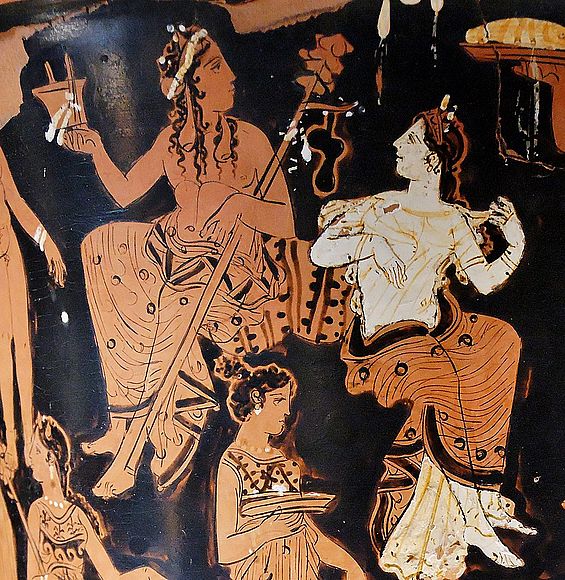
Dionysos & Ariadne; the Louvre -CA929.jpg
Credit - https://commons.wikimedia.org/wiki/File.
Located some distance beneath the handle of the Plough lies Canes Venatici; the Herdsman’s dogs marked by just two stars. The brighter one, Cor Caroli, meaning Charles’s heart, was named in honour of King Charles II. The constellation may be small but contains many deep sky objects within its confines including M51 - the Whirlpool galaxy, M3 - globular cluster, M63, M94, M106 - all galaxies, as well as NGC 4631 - the Whale galaxy.
Winding between the two celestial bears are the stars of the celestial dragon - Draco, the head of which resides not far from Vega. Overhead the faint pattern of Cepheus resembles the outline of a crooked house. It contains no apparent ‘showpiece’ objects but does contain the variable stars Delta and Mu. Mu is known as the Garnet star, one of the reddest stars visible in the heavens. Delta Cephei is the prototype star of its class, very large, luminous, yellow stars the periods of which are directly linked to their mass. Such stars are seen as ‘standard candles’ being of immense value in estimating both stellar and galactic distances.
Residing adjacent to Cepheus sits the distinctive pattern of Queen Cassiopeia the outline of which resembles that of ‘W’ or ‘M’. It is a constellation well worth exploring with binoculars or telescope, especially as the Milky Way flows through it. Following Cassiopeia, climbing up toward the zenith from the NE is ‘son in law’ Perseus, the pattern of which reminds a little of Isobar lines sweeping across a weather chart. Beta Persei or Algol, is a most interesting variable star, an eclipsing binary system causing Algol to 'wink' every 3rd day. It is known as the 'Demon' star, more on this next month Perseus also contains some fine deep sky objects, in particular the Perseus double cluster regarded by many amateur astronomers as one of the loveliest sights visible in smaller instruments, a stellar jewel box!
Following Perseus, climbing away from the NE horizon is the brilliant star Capella, chief luminary in the pentangle outline of Auriga the charioteer. Capella is a circumpolar winter star spending its summer low to north before arcing up toward the zenith overhead as winter commences.
Anyone not familiar with the workings of the night sky may naturally assume that although autumn has arrived, stars associated with summer have departed. Yet as twilight deepens many constellations associated with summer remain well placed for viewing. Particularly noticeable are the three bright stars of the summer triangle., the lovely steely blue hue of Vega in the lozenge shaped group of Lyra is most conspicuous high in the NW.
Cygnus the Swan, also known as the Northern Cross, hangs like a crucifix from its chief star Deneb high to the west. Both groups are circumpolar, visible all year, being sufficiently far north of the celestial equator not to set from our latitude. Of the summer trio only Altair, chief star in Aquila the Eagle migrates south for the winter, setting shortly after 22:30hrs due west. A short distance above Altair in Aquila, note the small arrow shaped group of Sagitta together with the close-knit group of Delphinus situated to its left. Delphinus is one pattern that with a little imagination does resemble the outline of a dolphin leaping out of water. It is sometimes known as ‘Jobs coffin'. Between Cygnus and Sagitta a smattering of stars mark Vulpecula - the Fox in which the fine planetary nebula M27 - the Dumbbell resides.
Stradling the horizon to the south lie the stars of Sagittarius - the Archer, never seen in its entirety from UK shores. If skies are transparent look for the large asterism referred to as the ‘Teapot’, the outline of which resembles a more ‘angular’ type of pot slightly tilted as if pouring a cuppa! A crescent Moon illuminates the 'pot' from within on Oct 20th - 06:50hrs BST.
The eastern aspect of the sky is dominated by just a few constellations, in particular the winged horse Pegasus, which stands 2-3 hand-spans above the horizon. It is best identified by autumn's signature asterism the “the great square”, an arrangement of four stars enclosing a large area of sky seemingly devoid of naked eye stars. The asterism is particularly useful as a signpost to those fainter constellations visible low to east and southeast. Travelling clockwise from the top left-hand star in the square, Alpheratz, we in turn encounter Scheat, Markab and Algenib. Alpheratz (alpha andromeda), the main body of which extends away to the east and is the jump off point for locating the Andromeda galaxy, our sister galaxy (see last month - September Night Sky).
Below Andromeda sit two small constellations, Triangulum, below which lie the crooked line of stars marking Aries - the Ram. Along with the Andromeda galaxy and the Milky Way, the third spiral galaxy in our local group is in Triangulum -M33 (the other pinwheel galaxy in the sky), seen as a misty patch in binoculars or rich field telescopes.
Return to the square and by Projecting a line diagonally from Alpheratz down through Markab (alpha Pegasi), the bottom right star of the square, will guide the observer to a zig-zag asterism of stars representing the ‘water jar’, part of the constellation of Aquarius, the Water Bearer. According to one legend this group represents Zeus pouring down the waters of life from heaven. Several stars in Aquarius have names beginning with ‘Sad’ which in Arabic means ‘luck’ (sa’d). Continue this baring and you run into Capricornus located above the SSW horizon.
Toward the end of October, the most southerly first magnitude star to rise over the UK begins its short apparition. Fomalhaut marks the mouth of Pisces Austrinus, the Southern Fish, into which the waters of Aquarius pour. Conveniently, a line drawn down through the two right hand stars in the ‘square’ (Scheat and Markab) point directly to its location just above the S horizon. Fomalhaut is located 25 light years away and has at least one planet orbiting around it.
Finally, charging over the horizon in the ENE are the stars of Taurus the Bull, led by the exquisite open cluster of the Pleiades or Seven Sisters marking the bull's tail. The sight of the Pleiades a sign that winter is fast approaching - at least in the sky, but for the time being Autumn takes centre stage!
October Sky Charts.
Additional Image Credits:
- Planets and Comets where not otherwise mentioned: NASA
- Sky Charts: Stellarium Software and Starry Night Pro Plus 8
- Log in to post comments

